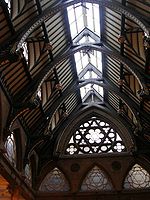
Wool Exchange, Bradford
Encyclopedia

Bradford
Bradford lies at the heart of the City of Bradford, a metropolitan borough of West Yorkshire, in Northern England. It is situated in the foothills of the Pennines, west of Leeds, and northwest of Wakefield. Bradford became a municipal borough in 1847, and received its charter as a city in 1897...
, West Yorkshire
West Yorkshire
West Yorkshire is a metropolitan county within the Yorkshire and the Humber region of England with a population of 2.2 million. West Yorkshire came into existence as a metropolitan county in 1974 after the passage of the Local Government Act 1972....
, England
England
England is a country that is part of the United Kingdom. It shares land borders with Scotland to the north and Wales to the west; the Irish Sea is to the north west, the Celtic Sea to the south west, with the North Sea to the east and the English Channel to the south separating it from continental...
is a grade I-listed building built as a wool-trading centre in the 19th century. The grandeur of its Gothic Revival architecture is symbolic of the wealth and importance that wool brought to Bradford. Today it contains a small shopping centre.
Design history
It was built between 1864 and 1867.Images of England.org.uk: National Monuments Record. The commission to design the building was given great importance in Bradford and John RuskinJohn Ruskin
John Ruskin was the leading English art critic of the Victorian era, also an art patron, draughtsman, watercolourist, a prominent social thinker and philanthropist. He wrote on subjects ranging from geology to architecture, myth to ornithology, literature to education, and botany to political...
was invited to give his advice. There was a competition to design the building: entries included one from Norman Shaw, but it was won by the local architects Lockwood
Henry Francis Lockwood
Henry Francis Lockwood was an influential architect, born at Doncaster on 18 September 1811. His father and grandfather were mayors of Doncaster. He married Emma Day whose great uncle, Charles Day , made a fortune through the Day and Martin company...
and Mawson. The foundation stone was laid by the then Prime Minister, Lord Palmerston. The architectural style employed is Venetian Gothic
Venetian Gothic architecture
Venetian Gothic is a term given to an architectural style combining use of the Gothic lancet arch with Byzantine and Moorish architecture influences. The style originated in 14th century Venice with the confluence of Byzantine styles from Constantinople, Arab influences from Moorish Spain and early...
with some Flemish influence in the tower. The accompanying photograph shows the architectural detail of the tower and arcading well, but the light is not strong enough for the contrasting stone colours to emerge. When the building was listed in 1963, the interior of the hall was officially described as follows:
"The main hall is still used as a Wool exchange and has finely detailed lofty hammer-beam roof with wrought iron work decoration. The hall is surrounded by tall polished granite columns with foliate capitals and there is an outer south aisle arcade with good naturalistic foliage carving. Lively wrought ironwork balcony and staircase balustrade." National Monuments Record.
Trading practices

Spinks' restaurant
Almost as socially important as the Exchange itself was Spinks' restaurant (with its trademark Egyptian sphinx embossed on all the cutlery) which was in a semi-basement below the building. There were two public rooms: the dining room for full meals, and the buttery which served snacks and drinks only. In practice, almost as much trading and networking went on in these two rooms as on the floor upstairs. Since the restaurant was open to the public, not just to members, the place was a centre for Bradford business life in general.The building today
The building has not been used for trading wool since the 1960s. Waterstone'sWaterstone's
Waterstone's is a British book specialist established in 1982 by Tim Waterstone that employs around 4,500 staff throughout the United Kingdom and Europe....
uses the ground floor area for book sales. The best views of the interior are available from the Starbucks
Starbucks
Starbucks Corporation is an international coffee and coffeehouse chain based in Seattle, Washington. Starbucks is the largest coffeehouse company in the world, with 17,009 stores in 55 countries, including over 11,000 in the United States, over 1,000 in Canada, over 700 in the United Kingdom, and...
coffee shop on the mezzanine floor. Modern plate-glass windows on this side of the building let in plenty of natural light: something that was lacking in the old days of wool-trading.
As well as Waterstone's and Starbucks, the building currently hosts a newsagent, pizza restaurant, panini shop, employment agency and the Exchange Ale House. The exterior has sculptures of various heroes of the textile industry such as Joseph Marie Jacquard
Joseph Marie Jacquard
Joseph Marie Charles dit Jacquard played an important role in the development of the earliest programmable loom , which in turn played an important role in the development of other programmable machines, such as computers.- Early life :Jean Jacquard’s name was not really...
and also explorers and politicians.
The building stands opposite Arndale House, which was built on the site of the Victorian Swan Arcade
Swan Arcade, Bradford
The Swan Arcade was a four-storey building located between Market Street and Broadway, Bradford, UK and stood opposite the Wool Exchange. The Bradford Beck ran beneath.- Architecture and history :...
, the former workplace of J B Priestley which was controversially demolished in 1962.

